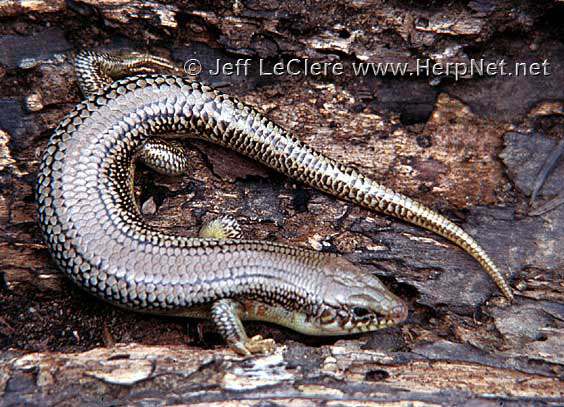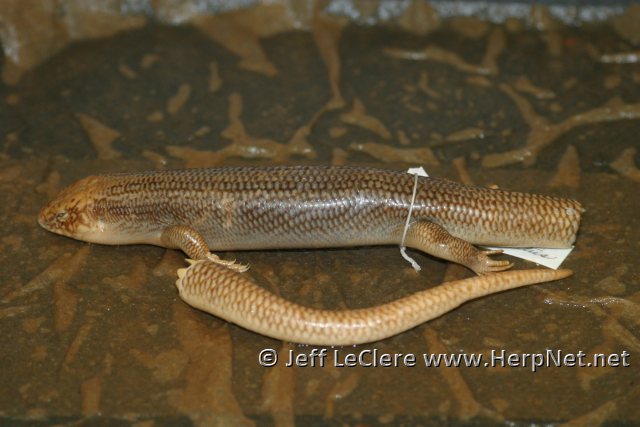Great Plains Skink (Plestiodon obsoletus)
by Jeff LeClere

Status
Great Plains skinks are listed as an ENDANGERED species and Species of Greatest Conservation Need in Iowa due to their restricted range.The former scientific name for this lizard was Eumeces obsoletus.
Description
The Great Plains skink reaches nearly 14 inches total length (Conant and Collins 1991). Scalation appears same as in the other skinks; smooth, but the lateral scales are arranged in uneven, oblique rows. The other two skinks have uniform lateral scale rows. Great Plains skinks also look different than the other two skink species in Iowa. Adults are brown or black with a gold or light colored dot on each scale. This coloration often takes over to produce a gold or tan lizard with black dots. The dark dots are sometimes arranged in such a way as to give the appearance of dark stripes, but these are not clean cut.
These lizards are much larger than the other two Iowa skink species. Young are black with white dots on the lips, head and neck. The tail is bluish. Some specimens may have bright blue tails, but it may be difficult to see in others. They are about 2 1/2 inches at hatching.
Subspecies
There are no recognized subspecies of the Great Plains skink, Plestiodon obsoletus.
Range

The Great Plains skink just barely ranges into Iowa in the extreme southwestern corner of the state. Any sightings of this lizard should be reported (photos very useful!) to the DNR or us. In the rest of their Great Plains range west of Iowa, they are a very common lizard.
Habitat
Great Plains skinks are from open plains habitats. Open, rolling grasslands with few trees and scattered rocks are good habitats. In Iowa, they are found on slopes of a very small portion of the Loess Hills.
Habits
Great Plains skinks emerge from their winter dormancy in April. They may bask atop rocks or logs and actively forage for their food. They are diurnal, but they often take refuge under rocks or logs during the hottest parts of the day in mid-summer. These skinks are accomplished burrowers, and often form dugouts under rocks or similar cover. They are drawn to junk where they can search for food and find shelter. Boards, tin, logs, and other structures may be used by these lizards. Increased awareness by the general public will hopefully lead to the reporting of populations in new areas.

Breeding occurs in spring. The male grasps the skin of the female’s neck during copulation. They are oviparous laying from 5 to 32 eggs (average 12) (Collins, 1993) in June inside small excavations under forms of cover such as rocks, logs or boards. Females guard the eggs. The eggs hatch in August. All of Iowa’s lizards are quick and rely on speed to escape when they are out and about. The skinks look like small snakes slithering through the brush as they move their bodies in a very serpentine way when they run. One must use caution when trying to capture skinks. Often one will end up with nothing but a wriggling tail as the lizard scoots off to safety. Skinks may also break their tails off by themselves by pushing it against a solid structure. The tail will regenerate, but it will have no pattern, will have slightly different scalation, and will never be as long as the original one.
Great Plains skinks overwinter underground in burrows they dig, or abandoned mammal burrows. The adults usually begin hibernating in September, the juveniles a bit later.
Food
All five species of Iowa’s lizards eat small invertebrates such as crickets, grasshoppers, beetles, spiders, caterpillars, which they chase down and eat. They mash their food up with their strong jaws before swallowing their prey.

